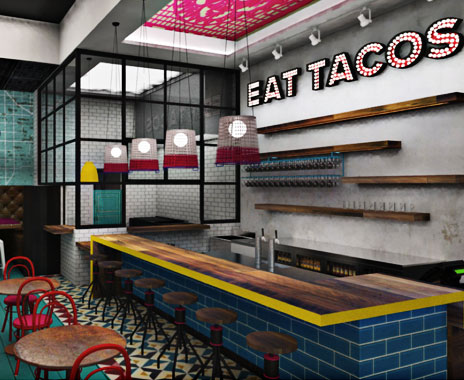Fast casual has dominated foodservice success stories in recent years, with the category sporting an 11 percent sales hike in 2013, according to Technomic. That success has inspired several traditional quick-service brands to jump on the fast-casual bandwagon with wholly new sister brands, the latest example being Taco Bell with its new U.S. Taco Co. and Urban Taproom brand.
With its edgy “Day of the Dead” theming and upscale fusion menu items, U.S. Taco Co. aims to stand out from both Taco Bell as well as other fast-casual operators.
“Taco Bell is Mexican-inspired food and U.S. Taco Co. and Urban Taproom is American food with a Mexican twist,” says Jeff Jenkins, a Taco Bell senior brand manager who is part of the U.S. Taco Co. development team. “The group [of consumers] that U.S. Taco is going after wants more of a sit-down, immersive experience with food theater, the plating, and the way food is delivered to the table.”
When Taco Bell executives conducted an extensive consumer segmentation study on how consumers interact with food and Taco Bell last year, they discovered a segment of the population they were not serving. “What surprised us was … that there are a lot of people who eat Mexican food who don’t come to quick-service restaurants and Taco bell, and there is an opportunity in the fast-casual arena,” Jenkins says. “People are looking for that food experience.”
The U.S. Taco menu offers a take on American classics. Instead of burgers, fries, and shakes, the brand sports upscale tacos, fries, and shakes. There are 10 featured tacos—served open, with fillings piled on top of tortillas—including the Winner Winner, with crispy chicken and gravy, and the Brotherly Love, featuring carne asada steak, grilled peppers, and onions. The brand will also offer a variety of loaded fries and shakes, such as the Mexican Car Bomb with Guinness Stout. U.S. Taco Co. will also serve beer and wine.
There are other stark differences between the Taco Bell brand and its new fast-casual concept. The average check at U.S. Taco Co. will be between $10 and $12, versus an average check of $4–$7 at Taco Bell. “Value and convenience are not at the heart of this consumer group [that will visit U.S. Taco],” Jenkins says.
Food preparation and service will also be decidedly fast casual.
“We will not have a drive thru; it’s all about sitting down and eating,” he says. “Visually, we want to make sure you understand the care and craft that we will be giving your food. The kitchen is enclosed in glass, so you can see how we are preparing the food, food-theater style.”
The first U.S. Taco Co. will open in Huntington Beach, California, sometime this summer and the second location—the only other unit publicly announced by Taco Bell—will open somewhere in Southern California later this year.
Taco Bell is the latest in a string of quick-serve operators to delve into the profitable fast-casual category. Yum Brands’ KFC debuted KFC eleven in Louisville, Kentucky, last August, serving up premium fare like Sweet Orange Ginger Flatbreads and Southwestern Baja Rice Bowls, made fresh to order in front of guests.
Sbarro, meanwhile, opened its first Pizza Cucinova restaurant last fall in Columbus, Ohio. “This is a completely separate concept, designed to be developed primarily in strip centers,” J. David Karam, chief executive of Sbarro, told QSR at the time. “It’s part of a fast-emerging category.”
The quick-serve operators who are entering the fast-casual segment are taking their time in developing the sister brands, typically opening one or two units near their home offices in order to gauge customer reactions and make changes before full-scale rollouts.
“Instead of doing market research, we said, ‘We have to build a concept; let’s get this thing live,’” Taco Bell’s Jenkins says. “We may not have the right first 10 tacos, but we have about 20 in our back pocket [that we can switch out] after we get live feedback from our customers.”
David Kincheloe, president of National Restaurant Consultants, says the slow-and-steady process of testing a fast-casual brand is the smart approach for quick-serve operators looking to enter the growing category.
“You do one unit to test the concept and the second to prove it,” he says, adding that an important goal is to not dilute the original core brand. “When you think of Taco Bell, you think of something specific: quick Mexican food that you can grab on the go. They have the potential for diluting the brand name and their consumer is going to be confused as where to go.”
Jenkins says Taco Bell executives are very aware of the brand dilution concerns and are taking steps to prevent that. “When you look at the positioning of the two brands, they are very different and will be very distinct from each other,” he says.











